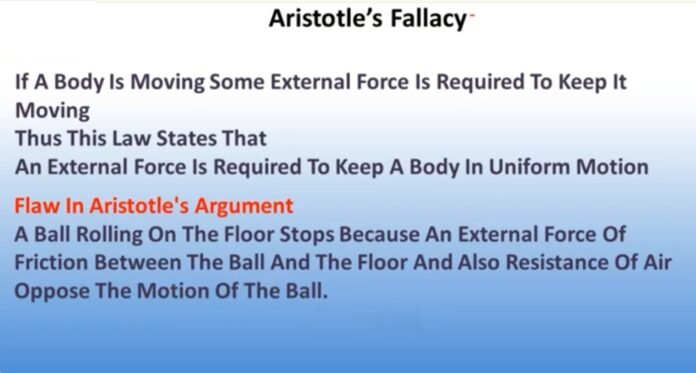Fallacy- A general kind of appeal or category of argument which looks a lot like a decent perceptive.
Aristotle makes the observations from practical experience and gives the conclusion that – An external force is required to keep a body in uniform motion. This is known as Aristotle’s fallacy.
What is Fallacy?
Fallacy- It is a generic type of appeal or a category of reasoning that appears to be reasonable.
Aristotle Fallacy
The Greek thinker Aristotle held the view that if a body is moving, some external force is required to keep it in the motion.
Aristotelian law of motion is – An external force is required for keeping a body in a uniform motion.
In our daily life we observe some objects and living things in motion. The only non-living objects are the objects that we can set into motion.
Let we set a football or a toy car in motion on the plane surface by applying some external force.
Does it require an external force to stay in a motion?
We will discuss about the toy that required an external force to continue to stay in motion. Once you remove your force out of the car, it will stop gradually.
In case of football, it is
also the same. When we roll a football on the smooth surface, it comes to rest
gradually. We can also make into the motion when we apply the external force again on it.
Aristotle Law of Motion
Aristotle’s Law of Motion – It states that an external force is needed to keep the body in a motion.
Aristotle gives the statement on the laws of motion. According to Aristotle, an object stay in the state of uniform motion by the application of an external force. The object should moving with the force without stopping.
The laws of motion denied Aristotle’s fallacy.
According to him, an object that is in motion should stop gradually without any external force. The force is necessary for the object for its motion.
What is the flaw in Aristotle’s Law of Motion?
According to Aristotle’s Fallacy- In the absence of an external force, a body in motion will be in uniform motion forever. Aristotle failed to understand this concept and set his argument based on practical experiences only.
Types of Fallacy
Fallacy are divided into two categories –
· Formal fallacies
· Informal Fallacies
Formal fallacies
Formal Fallacy are divided into Three categories-
1) Quantification fallacies
2) Syllogistic fallacies
3) Propositional fallacies
Informal fallacies
The Informal Fallacies are divided into Five Categories-
1) Improper premise
2) Faulty generalizations
3) Red herring fallacies
4) Questionable cause
5) Relevance fallacies
Aristotle Fallacy
According to the theory of Aristotle-
An external force is required to keep a moving body in a state of uniform motion.
Aristotle’s theory was framed by considering just one side of the motion.
He couldn’t explain how a moving object comes to rest. This introduced the world to the concept of friction which is used as an opposing external force.
Recommended Articles:
Archimedes Principle an Overview and facts
Various Apps For Physics and Its Information
Applications of Ultrasound with Full Concept
Angular and Linear Velocity
Angular Speed: Formula, Units, Applications, Factors, and Examples
Aristotle Law of Motion- It states that an external force is required to keep the body in motion. Aristotle made observations from practical experiences and give conclusion that an external force is required to keep a body in uniform motion. This is known as Aristotle's fallacy. Fallacies are basically divided into two categories, that is Formal fallacies and Informal Fallacies.The formal fallacies contain Quantification, Propositional and Syllogistic Fallacies. No, The body will not require any external force to retain uniform Motion. According to Newton’s Law of Motion – A body is continuous remain in the state of motion or state of rest until and unless there is no force applied to stop the object Fallacies are basically divided into two categories, that is Formal fallacies and Informal Fallacies. The Informal Fallacies are divided into five categories which contain Improper premise, Faulty generalizations, Red herring fallacies, Questionable cause and Relevance fallacies.”
State Aristotle law of motion?
What is Aristotle Fallacy?
Write a different type of Formal Fallacy?
Does an external force is required to retain a body in uniform motion?
Write a different type of Informal Fallacy?
